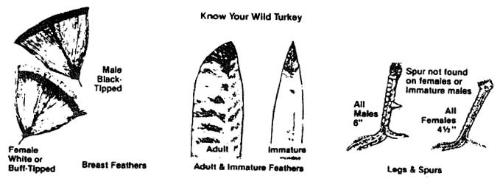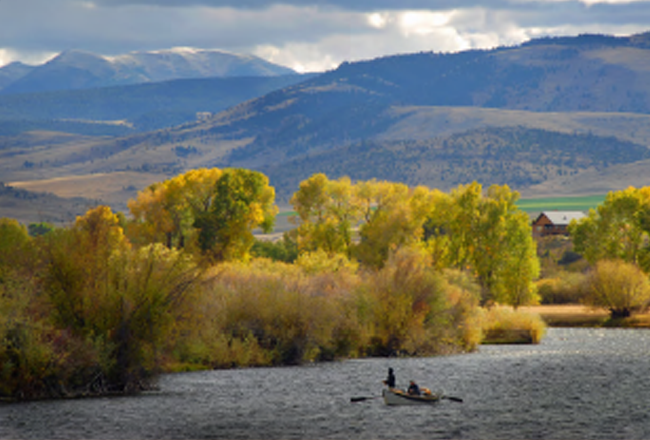MyFWP
Have you set up your MyFWP account?
- Tap harvest data by district and species
- Track your points and permit status
- Purchase licenses and apply
- Get detailed river access information
- Receive date reminders and updates by email


Sign up to receive email or text notifications about important hunting and fishing news and announcements.
Regulations for upcoming seasons are posted online throughout the year. Turkey regulations are typically posted early March.
All downloads below are in PDF format.
2025 Turkey Regulations (PDF)
Launch maps, obtain legal descriptions, regulations, and statistics all in one place.
These dates are provided only as a general reference. Check current regulations or use FWP's online Hunt Planner for specific dates.
Spring: April 15- May 31
Fall: Sept. 1 - Jan. 1
A turkey hunter may hold up to 11 wild turkey licenses per year. This may include:
1 General Turkey License valid statewide for male turkey in the spring and for either-sex turkey in Regions 1-3 and 5-7 in the fall;
1 Regional Turkey License in each of Regions 1, 2, 5 & 7 valid for male turkey in the spring and either-sex turkey in the fall (Region 5 license only valid in the spring);
1 Female or Beardless Turkey License in Region 1;
4 Female or Beardless Turkey Licenses valid in Missoula and Ravalli counties;
1 Female or Beardless Turkey License valid in Missoula, Ravalli and Mineral counties.
Details: Prerequisite of Upland Game Bird license
Fees:
Resident: $6.50
Nonresident: $57.50
Fees:
Resident: N/A
Nonresident: $115
Availability
This license is available Over the Counter.
Availability
This license is available Over the Counter.
The Merriam’s turkey represents one of Montana's most prized upland game birds. A flock of wild turkeys moving across a hillside studded with ponderosa pine has become an exciting-and permanent-addition to Montana's wildlife and hunting scene. This serves as a fitting tribute to the sportsmen who worked so hard to insure that introduction of the wild turkey into Montana would be a success.
Montana falls outside the wild turkey's ancestral range and it is not native to Montana. When the Montana Department of Fish and Game decided to introduce turkeys into Montana, it selected the Merriam's as the best choice to achieve success. In 1954, department biologists introduced 13 Colorado birds into the Judith Mountains of central Montana. A second release was made in 1955 when 18 turkeys from Wyoming were released into the Long Pines area of southeastern Montana. Wyoming stock was also used in the Ashland area of southeastern Montana in 1956 and 1957 when 26 birds were released. This marked the last time stock from outside Montana was transplanted. Subsequent trapping and relocating distributed turkeys through numerous sites in Montana.
Montana has a spring gobbler season and an either-sex fall season. Hunters are required to purchase a turkey tag in addition to a bird and conservation license. Hunters are allowed one wild turkey per special tag holder per special season. Popular hunting areas include the Long Pines and Ashland areas of the Custer National Forest and portions of Fergus County and the Charles M. Russell National Wildlife Refuge. Specific information on season hunting dates, open and closed areas, and other information on regulations can be obtained from the turkey regulations for the spring and fall hunts.
Consistently, successful turkey hunting for toms requires a high degree of skill. Wild turkeys are extremely wary and possess keen color vision and good hearing ability. * Finding a place to hunt turkeys in the spring does not present major problems since much hunting in eastern Montana occurs on either U.S. Fish and Wildlife Service or Bureau of Land Management land. But finding turkeys can present a problem. Preseason scouting for sign left by turkeys is the best way to find a good hunting area. Signs to look for are roost trees, droppings, feathers, scratch and dusting areas. Also, listen for gobbling. Make a note of feeding areas. In the timbered areas, preferred roost trees are tall, over- mature and dead ponderosa pines that are sheltered from high winds. A lot of the turkey range east of the Continental Divide is on private property. You must have permission to hunt turkeys on private property.
Climbing a high butte during late afternoon and scanning the open park areas with a spotting scope is a good way to spot turkeys. If any toms are in the vicinity, chances are good they will be out in the open going through their courtship display. Once you spot a tom, mark his location and arrive there early the next morning before he leaves the roost tree. Some hunters use an owl hooter during the early morning to get roosted birds to call back. Hooters are commercial mouth-blown devices that imitate a large owl's hoot. Once a gobbler is located, the hunter can move in quietly, then hide and use his turkey call.
If you don't hear a bird gobble of its own volition, move through the woods and make several hen yelps every 300 to 400 yards. Such calling should be done only from a location where you can hide quickly and also have a good view of the surroundings.
Be in the woods by the crack of dawn because this is when the breeding-age toms begin sounding off with lusty gobbles audible half a mile away on a still morning. Breeding-age toms do most of their gobbling during the first two hours of daylight, but during the height of the mating season, an occasional gobble may be heard at any time of the day.
If you hear more than one tom gobbling, move in on the closest tom as fast as possible. Stalking a more distant tom may result in a busted stalk.
When calling to a tom on the roost early in the morning, a couple of soft, sleepy clucks works better than the hen yelp. A tom is reluctant to respond to a love yelp so early in the morning.
Whether you wear camouflage or not, your clothing should blend with the foliage around you. Although some hunters swear by facial camouflage and clothing, other good hunters are inclined to believe one's movements spook turkeys.
Where should you take a stand? After a gobbler sounds, try to move within 200 yards of his position and then choose a stand in a fairly open area. As a general rule, turkeys avoid thickets that could conceal an enemy. A turkey likes a certain amount of ground cover within the timber to make it feel secure. However, the ground cover must be open enough to instantly afford the turkey good vision, allow it to walk without touching or coming into bodily contact with thick ground growth and assure it quick wing action and passage if need be. Turkeys are like any other animals-their behavior is mostly directed toward survival. Once you are on a stand, sit still and be patient. Smoking, coughing and other unnecessary movements simply do not fit into the strategic plan for hunting turkeys.
Try to get uphill and on the same ridge as a gobbler. It's the easiest place to call from. Turkeys are a lot easier to call uphill than downhill.
When selecting a calling site, look for a tree with a good thick base. Sit in front of it, and use it as a backrest.
Weather conditions play a big part in the success of the spring gobbler hunt. A day that starts with a clear, cool morning and no wind is a good choice for hunting turkeys. Eastern Montana unfortunately has its share of inclement weather during the spring turkey season. Cold weather-especially when coupled with a foot of snow-usually dampens the amorous attitudes of gobblers, making calling almost useless. If such weather conditions occur, stay home, practice your calls, read up on the life history of the wild turkey and hope for a better day.
Rifles are not a legal weapon for the spring season, most turkey hunters prefer using a 12-gauge shotgun with a full choke and using 0.2 or No. 4 shot. Turkeys are big, tough birds, and their vital organs are tucked away beneath heavy, metallic-colored feathers. Breeding-age toms also have what is called a breast sponge, which acts like a flak jacket. It's a large mass of fatty tissue that helps them remain in prime physical condition during the breeding season. Wild turkeys also have blinding speed afoot, and even a broken wing seldom results in a turkey in the oven. Because a turkey's body is nothing less than a miniature armored-tank, preferred areas to shoot at are head and neck.
Selecting a call presents a bewildering problem for the beginner, especially if he asks for advice-few turkey hunters are likely to agree on a selection. This diversity is understandable, since calls differ widely in appearance and method of operation. One of the most popular and easiest to use is the large hinged-type box call. The top edges of the box are beveled and are chalked by the user. By drawing the paddle or lid very slowly and gently across either lip, the low, seductive mating yelp of a hen can be imitated. Concentrate your efforts on learning to imitate only the hen yelps and clucks. These are really the only two calls you have to learn for a successful hunt. The yelp is soft and plaintive and usually uttered in a series of threes. Visualize it as: "kee-yuk, kee-yuk, kee-yuk . . . . key-yuk, key- yuk." It must be done pleadingly with medium-pitched sounds, and with each perk ending on a rising inflection. A calling sequence should start with four or five yelps.
The rhythm of the yelping sequence is far more important than the tone, and this is what you should try to perfect when calling. Surprisingly enough, some hens will produce yelps that are really off key. When the hen is responsive to the gobbler, her call is snappy and to the point. As soon as you make some hen yelps, the tom will usually respond quickly with a gobble. Make a second call soon after the first to convince him that he really heard what he thought he did. Then, remain quiet for a while, regardless of how much he keeps gobbling. You can be sure he has zeroed in on your position and can come straight to you, if so inclined. If he is still gobbling from the same location 10-15 minutes after you last called to him, you might try a couple of clucks every 5 or 10 minutes until he comes in. If the bird is a 2-year old tom unable to gather a harem of hens, he will often move in quickly after hearing your hen yelps. But if you are working on a long-bearded old tom with a complement of hens in the vicinity, you are probably going to have a frustrating experience. The hens in his harem may go to him soon after he starts gobbling and your early morning efforts to lure him to you usually will be futile. A little patience and a different call may turn the tables. Under such a set of circumstances, a gobble from your box call may spell the margin of victory. Many box calls have a crisscross arrangement of rubber bands holding the lid gently to the box top. If you hold the call bottom down in the palm of your hand, handle pointed away from you, a quick shake will produce a gobble. This call often moves a hesitant tom into range because he thinks a rival gobbler is moving in on his hens. Use it with caution, however, because it also might call up another hunter.
Probably the best way to learn the yelping sequence of the hen turkey is to listen to a good caller or to a turkey-calling instructional record. If you are halfway serious about learning the basic calls, practice the yelping sequence outdoors throughout the year and don't wait until the day before the hunt to review your calling instructions and to begin practicing yelps.
Hens normally go to toms for breeding, so you'll have to do some good coaching to get the tom to come even a reasonable distance to you. A hen decoy can be placed in an open area within shotgun range of the caller. A young tom "jake" decoy can also be used near the hen to suggest competition for the older tom. Decoys can be purchased through large sporting goods stores, made from stuffed wild or domestic (not white) turkeys or made by yourself using foam, papier-mâché or other materials which can be easily worked and light enough to carry.
Immediately after killing your turkey, cut the month and date out and attach the carcass tag to the leg so that it may be easily inspected. Any bearded turkey taken in the spring season must have the beard attached while being transported. If the harvested spring gobbler is plucked or skinned for cold storage or transportation, the head and beard must remain attached.
The mature gobbler's typical head adornments and "beard" (a hair like appendage hanging from the upper breast) serve as good field marks in distinguishing the male from the female. However, up to 10 percent of the hens possess beards, and secondly, the gobbler's beard and head adornments are not readily visible until his second year. The only sure way to tell a gobbler from a hen is to examine the lower breast feathers. The tips are glossy black in males and white or buffy in females. Glassing turkeys from a distance with binoculars will readily show this difference. The outer two wing feathers will tell you whether the bird is a juvenile or an adult. If the feathers are sharply pointed and without transverse white bars extending to the tip, the bird is a poult (bird of the year). If the outer feather tips are somewhat rounded, and the white bars extend to the tip, the bird is an adult.

A safe turkey hunter, like a safe driver, is defensive minded. Below are some tips you should consider.
Select the largest stump, blow-down, tree-trunk, or rock to place your back against when calling; a hunter is more likely to spot another hunter moving to the front or side than from behind.
Eliminate the colors white, red, black and blue from your hunting outfit; this includes handkerchiefs, socks, under- wear, etc.
Select your calling spot in open timber rather than thick-- brush; eliminating movement is a key to success, not concealment.
In areas of high hunter concentrations, wear blaze orange when walking to and from your vehicle; this is also a good idea when carrying a bird out of the woods.
Be discreet when imitating the sound of a gobbling turkey.
When songbirds, crows or your turkey shuts up-look out; there's a good chance another hunter is moving in on your bird.
Never move, wave or make turkey sounds to alert another hunter of your presence; remain still, cough or holler. A quick movement may be your last. Use common sense.
Have you set up your MyFWP account?

